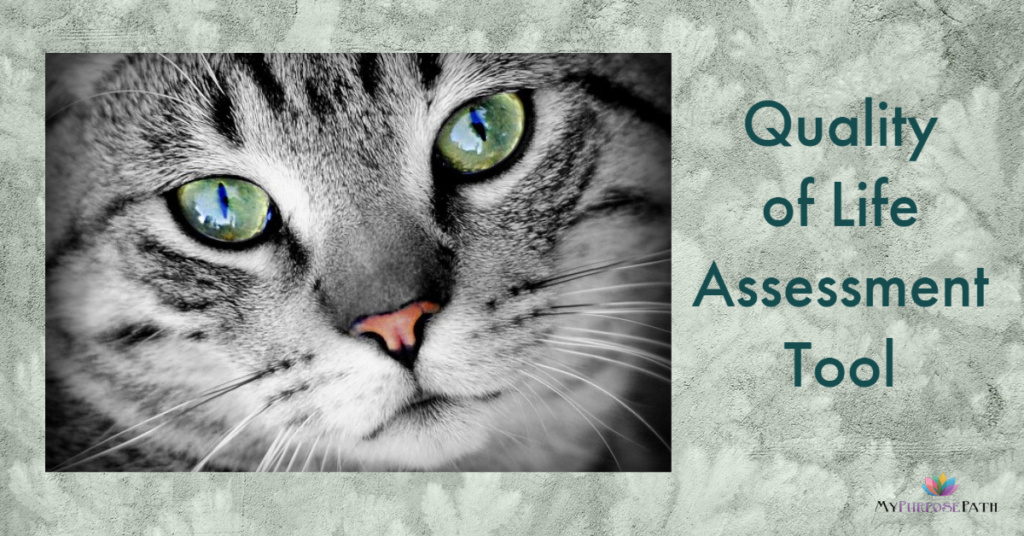
QUALITY-OF-LIFE Assessment Tool
A quality-of-life (QoL) assessment tool is used to help you determine your companion animal’s level of comfort and well-being as you come to the last part of his dying journey. When grappling with a natural death vs a death by euthanasia, we must consider what our friend is going through and a QoL tool helps us do that.
I found numerous versions of companion animal quality-of-life assessment tools online but decided to create my own. I use this with my animals and now take it with me when I visit my veterinarian when we’re navigating the final weeks and days with one of my animals. I use this for one of my dogs and one of my cats right now. This would need to be adjusted for equine. I’ve included it here for you as well. You can download it for your own animal.
Once you find a QoL tool that you like, stick with it to be sure to get the most consistent comparison data. If you find that it isn’t as helpful as you need it to be, find another that more closely aligns with the type of animal you have or with your animal’s needs.
Quality of life means different things to each of us. But it is important to get clear on what it means to you and your family. Basically, it refers to your animal’s daily life and how they feel, move, eat, and interact with the family.
It’s helpful to work through the whole tool at least once a month (perhaps more often, depending on how far along you are in the process of your animal’s pending death).
If you plan on a natural death, something could happen to change your mind quickly and force a euthanasia decision. Always consider the animal first, even if you were hoping to avoid euthanasia.
Using my QoL tool, make a list of your animal’s activities. Things they love to do along with their regular activities. There are spaces on my assessment tool for you to add and track your own.
Talk to your vet if you notice your animal’s attitude changing or their quality of life is declining. Sometimes additional medical support is available such as appetite stimulants, new medications to try, holistic methods that might help at the stage your animal has reached, joint supplements, and even toe-nail grips that can help with feet slipping (I wish I’d known about this one when my Petie kept slipping on the floor.).
I am not telling you what a good or bad QoL score might be. Think in terms of each of these areas and which are causing problems for you and your companion.
Draw a line in the sand
You know the old saying, I’m drawing a line in the sand. Right. Here. This is a point beyond which you will not go. It’s the limit of what you want to let your animal go through before you decide that it’s time.
Create a list of those things that you won’t tolerate for your animal. I call it my ‘line in the sand.’ Pain level is an important one. Talk to your veterinarian to discuss this in detail. Breathing issues are big on my own list. The inability for a large dog to walk could be another. If you can’t carry your dog to the yard, do you have another method of helping with elimination and keeping her clean? There are, of course, many other places you might draw the line in the sand and each depends on you and your animal.
This is important to get really clear on. You want to be ready to make a decision if they go downhill suddenly and are struggling.
A natural death can be preferable, but it can also be painful. There’s no need to let our creatures suffer with pain or breathing crises when we can help them with euthanasia.
So today, I have a line in the sand for my dog, Suki. When breathing becomes too difficult for her (she has congestive heart failure), I will let her go. If the doctor says her kidneys are shutting down, I will let her go. If the doctor says she’s suffering, I will ask in what way, and then I’ll make an informed decision.
QUALITY-OF-LIFE SCALE
Score each item 1 to 5 with 5 being the best or unchanged situation.
Have you noticed changes in:
- Pain management___ Does your dog need pain management? Daily? How long have you been doing this? Does she cry, whine, try to avoid touch?
- Appetite ___ eating the same, less, more?
- Hydration ___ same, less, more, not seeing him drinking?
- Sleeping ___ same, less, more?
- Restlessness ___ Same, less, more, Notice a difference? Pacing?
- In their favorite activities? ___ Still enjoys, less interested, not interested
- The amount of time they spend with you ___ same, less, more
- Enjoying the things they loved___ same, less, more
- Behavioral changes toward other pets ___ same, less, more, certain animals cause changes?
- Attitude Changes ___ Same, new aggressive, resource guarding, other
- Limp, whine, show of pain ___ avoiding touch, pain meds not working, not on pain meds yet.
- Breathing___ easily, with a bit of effort, rattling sounds and difficulty
- Elimination___ same, sporadic, seems difficult. Loss of control, cannot defecate
Notes: to discuss with your veterinarian_______________________________
